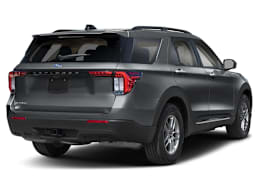The popular Explorer got a freshening for 2025 with upgraded cabin fit and finish, a larger infotainment screen and the availability of BlueCruise, Ford's hands-free driving assistance system. The below road test report is mostly based on our findings with a 2020 Ford Explorer XLT AWD.
Handling remains agile and the cabin is quiet and spacious. It's unfortunate that the 10-speed automatic is a bit clunky at low speed, especially with the standard 2.3-liter turbo. The ride is stiff-legged but well controlled and tied down.
The Explorer's rear-drive-based platform (most competitors are front-drive-based) contributes to its handling chops and tow rating—5,300 pounds on our test vehicle. Our all-wheel-drive Explorer proved adept through corners, with responsive steering and firm suspension that gave drivers confidence. Ride quality is less compliant than many rivals, though, and it transmits frequent jiggles into the cabin.
The 300-horsepower turbocharged engine has plenty of oomph to get the Explorer up to speed quickly, yet, at 21 mpg overall, this four-cylinder doesn't have a fuel economy advantage over some of its smoother V6 competitors. But the engine sounds raspy when accelerating, making the Explorer seem unrefined. The optional 3.0-liter V6 turbo is much more cultured.
Most people will be able to find a comfortable driving position easily, thanks to the Ford’s generous headroom, a wide range of seat adjustments, a large left footrest, and well-padded armrests. The controls are simple to use, and the infotainment system is intuitive and responds quickly. Fit and finish has improved lately, with better quality plastics and tighter panel fits. The cabin stays hushed even at highway speeds, although the turbo four-cylinder engine gets raspy when accelerating.
The second-row seats have plenty of room all around. They flip up easily with the pull of a lever to gain access to the third row, but this still leaves a narrow path that requires lots of ducking and twisting. The third-row seat has less room than before, is positioned low to the floor, and is tight on knee space—it's best-suited for small kids.
The Ford Co-Pilot360 Assist+ suite of advanced safety systems is now standard, including forward collision warning, automatic emergency braking with pedestrian detection, blind spot warning, rear cross traffic warning, lane departure warning, lane keeping assistance, adaptive cruise control, and lane centering assistance. Ford has made it easy for owners to find the settings for these features, and the company has even included animations on the center display screen to help explain what each system does. BlueCruise, which is Ford's hands-free combination of lane centering and adaptive cruise control, is available on higher trims with a subscription.























